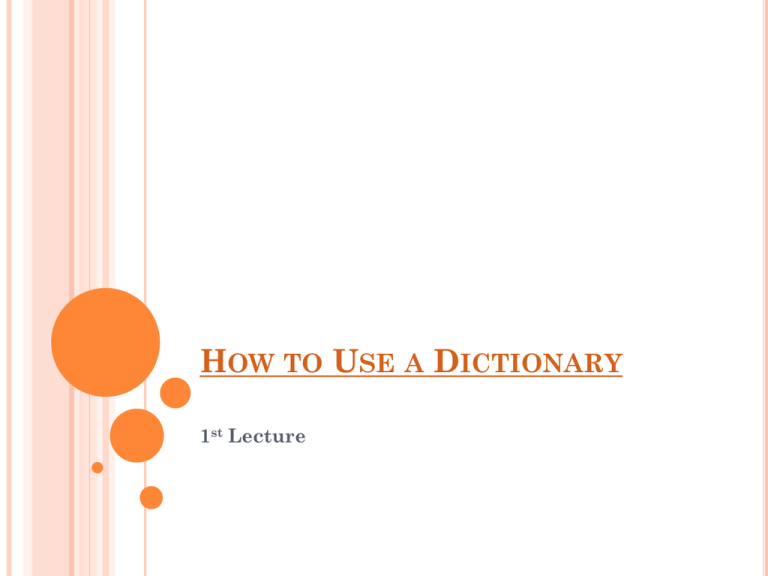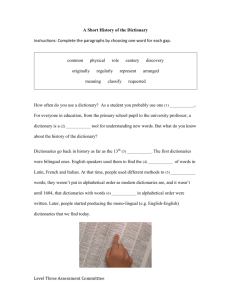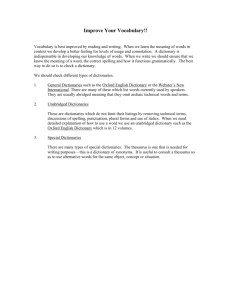(Translation)How to use a dictionary - 1st lecture
advertisement

HOW TO USE A DICTIONARY
1st Lecture
PART 1 OF 3: UNDERSTANDING YOUR
DICTIONARY
READ THE INTRODUCTION
- The best way to learn how to use your particular dictionary
effectively is to read its introductory section where you'll find
out how the entries are arranged. The introductory section of
your dictionary will explain important information such as
the abbreviations and pronunciation symbols used
throughout the entries.
-Introductions to dictionaries explain things like how
entries are arranged (they typically give the word, and the
variations of the word; whether part of speech the word is;
pronunciation of the word; definition, etc.). Reading the
introduction will give you a handle on how to find words and
how to use the information that you do find.
- There may also be information on pronunciation of words with
similar spellings; this can be helpful if you have only heard a
word and you're not sure of its spelling. For example, if you
hear "not", it might also be "knot" but the "k" is silent, and
this list can help you with suggestions.
LEARN THE ABBREVIATIONS
Dictionaries often have abbreviations in the
definitions for a word. This can be confusing if you
don't know what the abbreviations stand for.
Typically a dictionary will have a list of abbreviations
near the front of the book; either in the introduction,
or after it. For example "adj." stands for "adjective"
and will tell you what kind of word the word you're
looking up is. "Adv." or "advb." can stand for "adverb;
adverbially."
Something like "n." can stand for at least three
different things: the most obvious and common is
"noun," but it can also stand for "neuter" or "north"
depending on the context. So make sure that you
check the context of the word when you're looking it
up.
LEARN THE ABBREVIATIONS
LEARN THE GUIDE TO PRONUNCIATION
If you immediately jump right into reading the
dictionary without understanding the pronunciation
guide, it can be difficult to figure it out. Having an
idea about the symbols of pronunciation will make it
a lot easier for you.[4]The pronunciation of a word will
be placed between two reversed virgules (\ \) and will
typically be printed in italics.
A single stress mark (') precedes the strongest syllable
in a word.
The symbol \ä\ symbolizes the type of "a" sound that
appears in words like "caught," or "fought." Compare
this to the symbol \a\ which designates the sound "a"
in "mat, map, snap," and so on. The word doesn't
necessarily have to have the letter "a" to have a type
of "a" sound.
LEARN THE GUIDE TO PRONUNCIATION
PART 2 OF 3: LOOKING UP A WORD
FIND THE SECTION OF THE DICTIONARY
WITH FIRST LETTER OF YOUR WORD
Dictionaries follow alphabetical order. For example, "dog"
begins with "d" which means that it will be in the section
after "c" and before "e". Don't forget the possible spellings
for trickier words, such as "gnome" begins with a "g", or
"psychology" begins with a "p", or "knock" begins with a "k",
etc.
If you're not entirely sure what the first letter is, start with
the letter it sounds like. If you can't find the word under
that section, then try other sections. For example if you
didn't know that "psychology" begins with a "p" you might
start looking in the "s" section. When you couldn't find it
there, you might try looking in the "p" section next because
you can think along the lines of "psychic" and "psychosis."
Also, keep in mind that certain words sound alike that are
spelled very differently. For example, "throne" and
"thrown" are spelled differently and mean very different
things. So be careful that you end up with the correct word.
READ THE GUIDE WORDS
These are the two words at the top of the page that
tell you what types of words are on the page. These
words will help you find the word you're looking for in
the right letter section.[5]For example if you're looking
for the word "bramble" you would begin looking in the
"B" section. You would look at the tops of the pages as
you went through it until you came to the page with
the guide words "braid bread." This tells you that all
the words between braid and bread are on this page.
Since "bramble" starts with "b-r-a" it will be in this
section.
As always, the dictionary goes in alphabetical order,
so bramble (b-r-a) will come before bread (b-r-e).
READ THE GUIDE WORDS
Scan down the page for your word. If you
were looking for the word "futile," for
example, you would move past "furry" and
"fuse" and "fuss". Since the example word begins
with "f-u-t", go past all the "f-u-r" and all the "f-us" words alphabetically until you reach the "f-u-t"
area of the page. In this example, move right
down through "fut" and "Futhark" and this is
where you will find "futile."
READ THE DEFINITION
Once you've located the word it will tell you exactly what it
means (and if it has more than one meaning, it will tell you
the most common one first), how to pronounce it, how to
capitalize it (if it's a proper noun), what part of speech it is
and so on. Quite a few people get daunted by the definitions
themselves, because they can involve words that you have
to then look up. Don't feel discouraged. See if you can figure
out the meaning from the example sentences provided and
if not, look up the words you aren't sure of.
Dictionaries can also sometimes give the synonyms (words
that mean the same thing as your word) and the antonyms
of a word (words that mean the opposite of your word). So,
for example, if your word is futile some synonyms might be
"fruitless" or "unsuccessful" and some antonyms might be
"effective" or "helpful." You can also find near neighbor
words such as "futility".
READ THE DEFINITION
You might also find an etymology, derivation, or
history of the word. Even if you don't
know Latin or Ancient Greek, you may find that
this information helps you to remember or
understand the word.
Dictionaries also often provide spellings in other
English derivations (US English, British English,
Australian English, etc.).
PART 3 OF 3: USING YOUR DICTIONARY
FURTHER
Use the dictionary to find standard letter
forms. Hard copy dictionaries (rather than online
ones) often have standard letters for jobs, for RSVPs,
for filing complaints, for various official writings.
Research various facts. Dictionaries often have
more than just words and their definitions. Some of
them have lots of information about the world,
usually in the form of various lists. These include
geographical information (like maps, countries, cities,
capitals, etc.)Hard copy dictionaries often have
different weights and volumes, as well as conversion
tables. This can come in handy if you need to convert
pounds to kilograms or vice versa.
PART 3 OF 3: USING YOUR DICTIONARY
FURTHER
You can also usually find statistics on population
in various cities and countries, as well as lists of
the flags of different countries, states, provinces,
and regions around the world.
Many dictionaries also have lists of famous or
historical people, which you can peruse.







